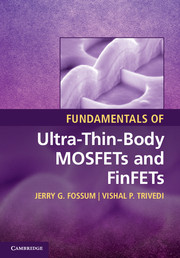Appendix - UFDG
Published online by Cambridge University Press: 05 September 2013
Summary
The process/physics-based compact model UFDG (Fossum et al., 2004a; Fossum, 2010) is generic, being applicable to Si-based ADG as well as SDG UTB MOSFETs, or FinFETs, to SG FD/SOI UTB MOSFETs (with negligible DC accumulation charge), and to independent-gate DG MOSFETs, or IGFETs. Because UFDG/Spice3 simulation results have been used throughout this book to enhance the discussions of UTB-device fundamentals, we include herein the UFDG MOSFET Model User’s Guide (Fossum, 2010) to give a detailed description of the model and its capabilities, as well as its use. The footnote citations in the Guide present details of the physical modeling contained in UFDG. The UFDG model is based on a self-consistent solution of the Schrödinger and Poisson equations in the UTB/channel of the device. It is, in essence, a compact Poisson–Schrödinger solver in a circuit simulator (Spice3). A variational approach, using a general description of the wave function as described in Chapter 2, is used to solve the Schrödinger equation, which is linked to Poisson’s equation via Newton–Raphson iteration. Use of 2-D density of states, with proper effective masses (defined by the Si surface orientation), and Fermi–Dirac statistics then characterizes the inversion-charge density and distribution in all the significant energy subbands for arbitrary gate biases. The quantization (QM) modeling includes dependences on UTB thickness (tSi) as well as transverse electric field (Ex). The carrier transport and channel current are modeled as quasi-ballistic via an accounting for velocity overshoot, derived from the Boltzmann transport equation and its moments, and a QM-based characterization of mobility as a function of tSi and Ex as well. UFDG is charge-based, with the terminal-charge modeling physically linked to the current modeling. In fact, the UFDG modeling is reflected well by the descriptions of generic UTB-device fundamentals in Chapter 2. The model has been verified by numerical device simulations and measured device data.
- Type
- Chapter
- Information
- Fundamentals of Ultra-Thin-Body MOSFETs and FinFETs , pp. 188 - 199Publisher: Cambridge University PressPrint publication year: 2013



